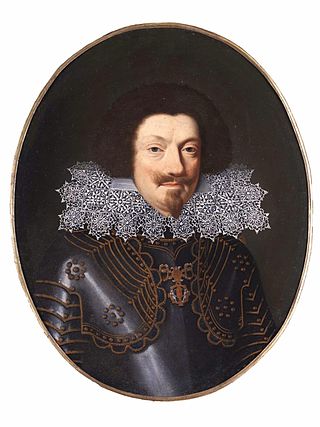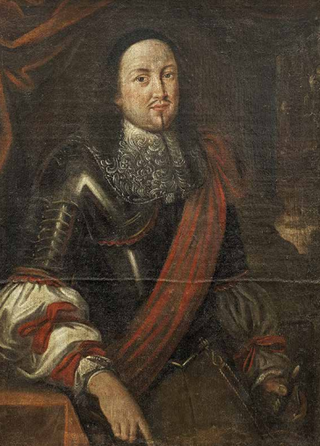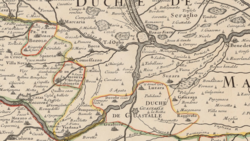
The House of Gonzaga is an Italian princely family that ruled Mantua in Lombardy, northern Italy from 1328 to 1708. They also ruled Monferrato in Piedmont and Nevers in France, as well as many other lesser fiefs throughout Europe. The family includes a saint, twelve cardinals and fourteen bishops. Two Gonzaga descendants became empresses of the Holy Roman Empire, and one became queen of Poland.

The Duke of Parma and Piacenza was the ruler of the Duchy of Parma and Piacenza, a historical state of Northern Italy. It was created by Pope Paul III for his son Pier Luigi Farnese. It existed between 1545 and 1802, and again from 1814 to 1859.

The Duchy of Parma and Piacenza was an Italian state created in 1545 and located in northern Italy, in the current region of Emilia-Romagna.

Guastalla is a town and comune in the province of Reggio Emilia in Emilia-Romagna, Italy.

The nobility of Italy comprised individuals and their families of the Italian Peninsula, and the islands linked with it, recognized by the sovereigns of the Italian city-states since the Middle Ages, and by the kings of Italy after the unification of the region into a single state, the Kingdom of Italy.

The War of the Mantuan Succession (1628–1631) was a conflict related to the Thirty Years' War and was caused by the death in December 1627 of Vincenzo II, the last male heir in the direct line of the House of Gonzaga and the ruler of the duchies of Mantua and Montferrat. Those territories were key to control of the Spanish Road, an overland route that allowed Habsburg Spain to move recruits and supplies from Italy to their army in Flanders. The result was a proxy war between France, which supported the French-born Duke of Nevers, and Spain, which backed a distant cousin, the Duke of Guastalla.

The Battle of Luzzara took place in Lombardy on 15 August 1702 during the War of the Spanish Succession, between a combined French and Savoyard army under Louis Joseph, duc de Vendôme, and an Imperial force under Prince Eugene.

Ferdinando Carlo Gonzaga was the only child of Duke Charles II of Mantua and Montferrat, and the last ruler of the Duchy of Mantua of the House of Gonzaga.

The County of Guastalla was a feudal state in northern Italy, centered on Guastalla. The title of count was created in 1406 for Guido Torelli.
Vincenzo Gonzaga was the reigning Duke of Guastalla and a member of the House of Gonzaga.
Emilia is a historical region of northern Italy, which approximately corresponds to the western and the north-eastern portions of the modern region of Emilia-Romagna, with the area of Romagna forming the remainder of the modern region.

The House of Bourbon-Parma is a cadet branch of the Spanish royal family, whose members once ruled as King of Etruria and as Duke of Parma and Piacenza, Guastalla, and Lucca. The House descended from the French Capetian dynasty in male line. Its name of Bourbon-Parma comes from the main name (Bourbon) and the other (Parma) from the title of Duke of Parma. The title was held by the Spanish Bourbons, as the founder Philip, Duke of Parma was the great-grandson of Ranuccio II Farnese, Duke of Parma. The House of Bourbon-Parma is today the Sovereign House of the Grand Duchy of Luxembourg (agnatically) and all members of the Grand Ducal Family of Luxembourg are members of the House of Bourbon-Parma with the title of "Princes/Princesses" and the predicate of Royal Highness.

Ferrante II Gonzaga was count and, from 1621, duke of Guastalla.

Ferrante III Gonzaga, was a Duke of Guastalla.

Giuseppe Gonzaga was the last reigning Duke of Guastalla and a member of the House of Gonzaga.

Isabella Clara of Austria was a Duchess consort of Mantua, Montferrat, Nevers, Mayenne and Rethel by marriage to Charles II, Duke of Mantua and Montferrat.

Anna Isabella Gonzaga, was a Duchess consort of Mantua and Montferrat and heiress of the Duchy of Guastalla, including Luzzara and Reggiolo; married in 1671 to Ferdinando Carlo Gonzaga, Duke of Mantua and Montferrat. She was the regent of Mantua in the absence of her spouse in 1691-1692, and during the War of the Spanish Succession in 1702-1703.

The Battle of Santa Vittoria was an encounter battle or skirmish in the Italian region of Emilia-Romagna on 26 July 1702 during the War of the Spanish Succession between a French force under Louis Joseph, duc de Vendôme and an Imperial cavalry detachment under General Annibal Visconti.
















